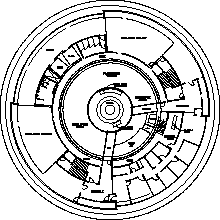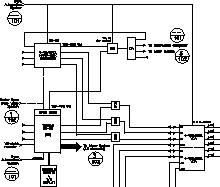October, 1997 marked the 30th anniversary of the H.R. MacMillan Planetarium
(located in Vancouver, BC). Starting in the Fall of 1995, we started on the design of a
significant upgrade for this facility. Our mandate was to replace the existing show
control system, laser projector, and slide projectors. We were also to upgrade the
front-end of the sound system, and to design a video distribution and projection system.
This was divided into two Phases that would be installed during two shut-down periods in
the Fall of ’96 and the Fall of ’97. Video
Video in a planetarium environment has some unique challenges. Unlike any other
projection venue, the screen is often totally black. This is a requirement to contribute
to the illusion of infinite vastness. Any images projected on this surface must not show
their projection boundaries, but must, rather, appear to float in the black void. Ideally,
the client wants a huge (greater than 12m/40 ft wide), bright image that will project an
inky black background – a clear impossibility with video projection.
After some research and in situ testing, we came up with a compromise solution. One or
more CRT-based video projectors would be used to provide smaller images with a background
black enough to vanish. For added flexibility, these projectors are mounted on motorised
X-Y platforms. This allows the video image to be positioned at a variety of locations on
the dome, and even to move (slew) while projecting.
For impact, a high-powered, large-venue projector was also chosen. This would give a
very large, bright image at a fixed location – compromise: the background would be
visible as a gray on the blackness of the dome. Using light requirements based on in situ
demonstrations, we determined how much light output would be required. The trick was to
avoid overkill by going for "more power," with no regard to how much is actually
needed. If the projector has too high a light output, the background gray will be too
objectionable. To help hide the background, we added a dowser to cut off light when no
image was being projected, and a series of motorised masks that can be moved in front of
the lens. When used judiciously (e.g.: projected when other projectors are spilling light
onto the dome, masking the image, using material that has a natural frame, etc.), this
large image adds great impact to the shows. image at a fixed location – compromise: the background would be
visible as a gray on the blackness of the dome. Using light requirements based on in situ
demonstrations, we determined how much light output would be required. The trick was to
avoid overkill by going for "more power," with no regard to how much is actually
needed. If the projector has too high a light output, the background gray will be too
objectionable. To help hide the background, we added a dowser to cut off light when no
image was being projected, and a series of motorised masks that can be moved in front of
the lens. When used judiciously (e.g.: projected when other projectors are spilling light
onto the dome, masking the image, using material that has a natural frame, etc.), this
large image adds great impact to the shows.
A very flexible matrix switching arrangement allows assignment of a variety of video
sources (e.g.: laser disk, Betacam, S-VHS), video processors (e.g.: faders and
mixers), and graphics sources (e.g.: a graphics server, line doublers, stage-mounted
computer input) to be assigned to any combination of projectors and console preview
monitors. All of this is dynamically controlled by the show controller.
Show Control
Planetarium automation systems are specialised, and differ widely in capabilities. We
sent a detailed questionnaire to eight vendors to determine the capabilities of their
systems, and to determine a budget price. Based on the client’s needs and budget, we
decided on three vendors from whom we would solicit bids.
The "traditional" approach for a planetarium is to ask for proposals from
each vendor. This approach, unfortunately, has a number of drawbacks. Typically, if you
request proposals from three vendors, you will receive three radically different proposals
with pricing varying considerably. This is analogous to requesting proposals from three
car dealers, and receiving one on a compact car, another on a luxury auto, and a third on
an all-terrain vehicle – while they are all cars, and have many elements in common, a
comparison is almost meaningless. There is also no guarantee that any one of them truly
meets the client’s needs.
We solved this problem by carefully
designing and specifying a system that would fit the capabilities of all the vendors
(albeit with varying degrees of customisation). Each bidder received the same bid package,
complete with detailed specifications and drawings. The specifications covered the
function and capabilities of the system in great detail (no vague or gray areas), as well
as the quality of workmanship required. This approach ensured the client that they were
getting quotes that were all based on precisely the same system – a system that
exactly met their needs.
Audio
 The planetarium already had a multi-channel sound system with 13 speakers
arranged in concentric rings going up the dome. This system allowed them to both patch any
source channel to any speaker or combination of speakers, and to "pan" a source
across a number of speakers. This system was about 15 years old, and the automation that
used to control it was no longer operational – it was tape-based, and the special
tape decks had finally worn out. Since our principal had been involved in the original
system design, we were able to design an interface that allowed the new show control
system to interface to the old sound control electronics and restore automation control of
audio levels and sound positioning. The planetarium already had a multi-channel sound system with 13 speakers
arranged in concentric rings going up the dome. This system allowed them to both patch any
source channel to any speaker or combination of speakers, and to "pan" a source
across a number of speakers. This system was about 15 years old, and the automation that
used to control it was no longer operational – it was tape-based, and the special
tape decks had finally worn out. Since our principal had been involved in the original
system design, we were able to design an interface that allowed the new show control
system to interface to the old sound control electronics and restore automation control of
audio levels and sound positioning.
The signal processors, the power amplifiers, and the speakers were still operating
satisfactorily, and we decided that there was no need to replace them. We did, however,
specify new equipment for the front-end: a 16-track digital tape transport for the primary
show sound-track and Laser control data; a 4-track HD recorder for random-access audio;
and a console mixer to accommodate microphones for the newly added stage.
Misc.
The Laser projector was upgraded (the existing lasers were re-used) to provide some
novel and sophisticated features. A Laser programming package (including a monitor) was
included. We again wrote a specification (with invaluable input from LaserHouse
Productions), and put out a bid package to three major Laser suppliers.
As design progressed on the show control system, it became obvious that the electrical
system also required upgrading. We decided to re-use the existing effects dimmer system
because it still functioned, had had few maintenance issues, and would save precious
budget funds. We used this opportunity to design a unique electronic "patch-bay"
into this existing effects dimming system to greatly increase the client’s effects
capacity and flexibility. We provided the necessary input to the electrical engineers, and
helped them review the electrical contractor’s installation of this highly unique
system.
The aging slide projectors were replaced with Kodak Ektapro’s. These are a new
generation of slide projector that features rapid random access capabilities as well as
RS-232 serial control. |

